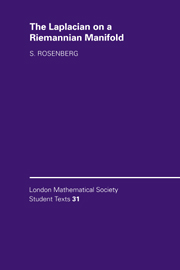2 - Elements of Differential Geometry
Published online by Cambridge University Press: 24 December 2009
Summary
In the first chapter we discussed heat flow on a compact manifold and the topological significance of the long time behavior of the heat flow. In contrast, the short time behavior of the heat flow might appear trivial, as we know the heat operator goes to the identity operator as t ↓ 0. However, we shall see in Chapter 3 that the way in which the heat kernel approaches the delta function (the kernel of the identity operator) is determined by the local Riemannian geometry of the manifold.
This chapter covers those parts of Riemannian geometry used to construct the heat kernel and its short time asymptotics in Chapter 3. We also prove Garding's inequality from Chapter 1, and develop some of the supersymmetric techniques used to prove the Chern-Gauss-Bonnet theorem in Chapter 4. The key concepts discussed are the various types of curvature in Riemannian geometry (§2.1), the Levi-Civita connection associated to a Riemannian metric (§2.2.1), the Weitzenböck formula and Gårding's inequality (§2.2.2), geodesies and Riemannian normal coordinates (§2.3). There is a technical section on the Laplacian in normal coordinates (§2.4). Other references for this material include [4], [27], [64, Vols. I, II].
Curvature
There is no better place to begin a discussion of curvature than with Gauss' solution to the question: when is a piece of a surface in R3 (such as the earth's surface) flat? By flat, we mean that there should exist a distortion free – i.e. isometric – map from the piece of the surface to a region in the standard plane.
- Type
- Chapter
- Information
- The Laplacian on a Riemannian ManifoldAn Introduction to Analysis on Manifolds, pp. 52 - 89Publisher: Cambridge University PressPrint publication year: 1997



